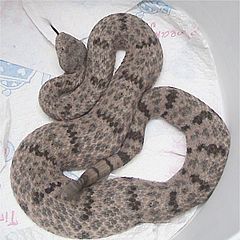- Crotalus lepidus
-
Crotalus lepidus 
Conservation status Scientific classification Kingdom: Animalia Phylum: Chordata Class: Reptilia Order: Squamata Suborder: Serpentes Family: Viperidae Genus: Crotalus Species: C. lepidus Binomial name Crotalus lepidus
(Kennicott, 1861)Synonyms - Caudisona lepida Kennicott, 1861
- A[ploaspis]. lepida - Cope, 1867
- Crotalus lepidus - Cope, 1883
- Crotalus [tigris var.] palmeri - Garman, 1887
- Crotalus palmeri - Günther, 1895
- Crotalus lepidus - Boulenger, 1896
- Crotalus lepidus lepidus - Gloyd, 1936[1]
- Common names: rock rattlesnake, green rattlesnake, blue rattlesnake, more.
Crotalus lepidus is a venomous pitviper species found in the southwestern United States and northern central Mexico. Four subspecies are currently recognized, including the nominate subspecies described here.[2]
Contents
Description
This is a small species that rarely exceeding 32" in length. They have a large, rounded head, and fairly heavy body for their size, with eyes that have vertical pupils. Like other rattlesnakes, their tail has a rattle on it, which is composed of keratin. Each time the snake sheds its skin, a new segment is added to the rattle, but the rattle is fragile and may break off, and the frequency of shedding can vary, so the snake's age cannot be determined by its length or number of segments.
The color pattern varies greatly, but generally reflects the color of the rock in their natural environment. Snakes found near areas that are predominantly limestone tend to be a light grey in color, with darker grey banding. Snakes found at higher altitudes have darker colors. Specimens of the mottled rock rattlesnake (C. l. lepidus) from the Davis Mountains region often exhibit a more pink coloration, with dark grey speckling rather than distinct banding.[1] The banded rock rattlesnake (C. l. klauberi) gets its common name from its distinctive, clean banding, often with little speckling or mottling.
Common names
Blue rattlesnake, Eastern rock rattlesnake, green rattlesnake, little green rattlesnake, pink rattlesnake, rock rattlesnake, Texas rock rattlesnake, white rattlesnake.[3]
Geographic range
Found in the southwestern United States (Arizona, southern New Mexico, and southwestern Texas) and northern central Mexico. The type locality given is "Presidio del Norte and Eagle Pass" (Texas, USA). H.M. Smith and Taylor (1950) emended the type locality to "Presidio (del Norte), Presidio County, Texas."[1]
Conservation status
This species is classified as Least Concern (LC) on the IUCN Red List of Threatened Species (v3.1, 2001).[4] Species are listed as such due to their wide distribution, presumed large population, or because it is unlikely to be declining fast enough to qualify for listing in a more threatened category. The population trend is stable. Year assessed: 2006.[5]
However, it is listed as a threatened species by the US state of New Mexico, although the state of Texas does not protect it. Its habitat is largely inaccessible, and not currently threatened by human development, though it is gradually becoming more and more fragmented.
Behavior
In general, these snakes are not aggressive. They tend to rely heavily on their camouflage, and will often not strike or even rattle their tails unless physically harassed. They spend most of their life in rocky outcroppings and talus slopes, which is where they get their name from. Man-made road cuts are often a favorite place. They are primarily nocturnal.
Feeding
Their diet consists of small mammals, lizards and sometimes frogs. They are often more active at colder temperatures than other rattlesnake species.
Captivity
Two subspecies, C. l. lepidus and C. l. klauberi, are frequently available in the exotic animal trade, and are well represented in zoos around the world. They are sought after for their wide array of potential colorations, and typically docile nature. Most available are wild caught; captive breeding, while not unheard of, is not commonplace. The two subspecies found only in Mexico are not often found in captivity outside of Mexico.
Reproduction
These snakes are ovoviviparous. They breed once a year, in the spring, and give birth approximately 4 months later to 6-8 young. The young generally look like miniature versions of the parents and take 3 or more years to mature.
Venom
The venom is primarily a haemotoxin, but has been known to have significant neurotoxic effects as well. While not type specific, the polyvalent antivenin CroFab is generally used to treat serious envenomations.
Subspecies
Subspecies Taxon author Common name Geographic range C. l. klauberi Gloyd, 1936 Banded Rock Rattlesnake Arizona, New Mexico, Texas, Mexico (south to Jalisco) C. l. lepidus Kennicott, 1861 Mottled Rock Rattlesnake New Mexico, Texas, Mexico (Chihuahua) C. l. maculosus Tanner, Dixon & Harris, 1972 Durango Rock rattlesnake Mexico (Durango, Sinaloa, Nayarit, Jalisco) C. l. morulus Klauber, 1952 Tamaulipan Rock rattlesnake Mexico (Sierra Madre Oriental) See also
- List of crotaline species and subspecies
- Crotalus by common name
- Crotalus by taxonomic synonyms
- Crotalinae by common name
- Crotalinae by taxonomic synonyms
- Snakebite
References
- ^ a b McDiarmid RW, Campbell JA, Touré T. 1999. Snake Species of the World: A Taxonomic and Geographic Reference, vol. 1. Herpetologists' League. 511 pp. ISBN 1-893777-00-6 (series). ISBN 1-893777-01-4 (volume).
- ^ "Crotalus lepidus". Integrated Taxonomic Information System. http://www.itis.gov/servlet/SingleRpt/SingleRpt?search_topic=TSN&search_value=174312. Retrieved 15 May 2007.
- ^ Wright AH, Wright AA. 1957. Handbook of Snakes. Comstock Publishing Associates. (7th printing, 1985). 1105 pp. ISBN 0-8014-0463-0.
- ^ Crotalus lepidus at the IUCN Red List. Accessed 13 September 2007.
- ^ 2001 Categories & Criteria (version 3.1) at the IUCN Red List. Accessed 13 September 2007.
External links
- Crotalus lepidus at the Reptarium.cz Reptile Database. Accessed 12 December 2007.
- Rock rattlesnake at Chihuahuan Desert Museum and Gardens. Accessed 12 December 2007.
- Crotalus lepidus at University of Texas. Accessed 12 December 2007.
- Mottled rock rattlesnake at kingsnake.com. Accessed 12 December 2007.
Categories:- IUCN Red List least concern species
- Crotalus
- Animals described in 1861
Wikimedia Foundation. 2010.



